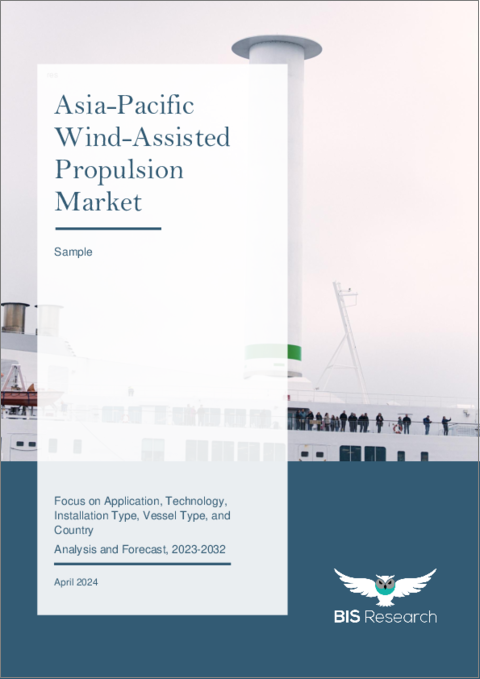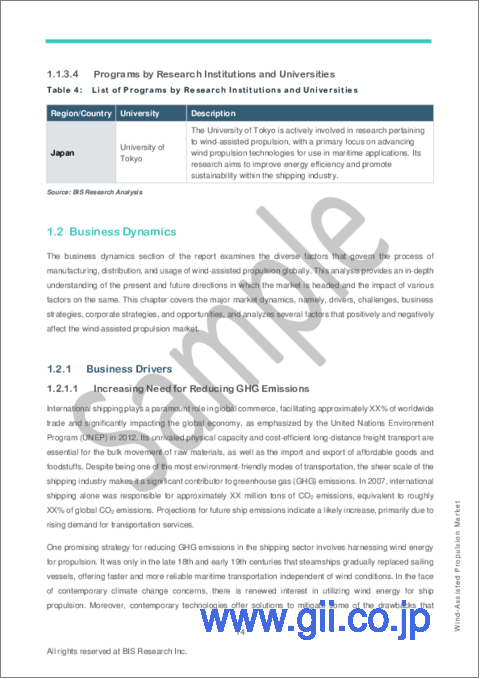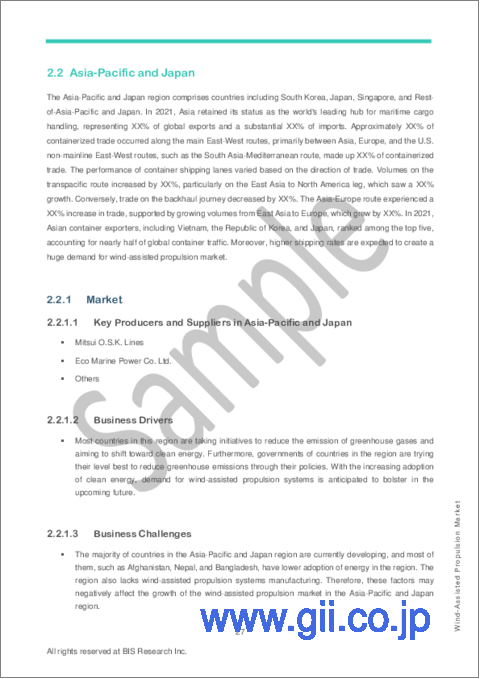|
|
市場調査レポート
商品コード
1473652
アジア太平洋の風力補助推進機市場:用途別、技術別、設置タイプ別、船舶タイプ別、国別:分析と予測(2023年~2032年)Asia-Pacific Wind-Assisted Propulsion Market: Focus on Application, Technology, Installation Type, Vessel Type, and Country - Analysis and Forecast, 2023-2032 |
||||||
カスタマイズ可能
|
|||||||
| アジア太平洋の風力補助推進機市場:用途別、技術別、設置タイプ別、船舶タイプ別、国別:分析と予測(2023年~2032年) |
|
出版日: 2024年05月07日
発行: BIS Research
ページ情報: 英文 86 Pages
納期: 1~5営業日
|
- 全表示
- 概要
- 図表
- 目次
アジア太平洋の風力補助推進機の市場規模(中国を除く)は、2023年の1,780万米ドルから2032年には37億1,700万米ドルに達し、予測期間の2023年~2032年のCAGRは81.01%になると予測されています。
同市場は、海上輸送における温室効果ガス排出削減の必要性が高まっていることから、大きな成長を遂げています。環境への懸念が最前線にある中、風力補助推進機のような持続可能なソリューションへの需要が高まっています。さらに、海上貿易の増加は、効率的で環境に優しい推進システムの必要性を増幅し、海運業界における風力補助技術の採用をさらに促進しています。
| 主要市場統計 | |
|---|---|
| 予測期間 | 2023年~2032年 |
| 2023年評価 | 1,780万米ドル |
| 2032年予測 | 37億1,700万米ドル |
| CAGR | 81.01% |
アジア太平洋(APAC)の風力補助推進機市場は、同地域の海運セクターの急成長と持続可能性への関心の高まりにより、大幅な成長を遂げています。アジア太平洋は国際貿易と海運の中心地であり、海上輸送における温室効果ガス排出を削減する必要性が高まっています。このような持続可能性に向けた動きが、風力補助推進技術の需要を促進しています。さらに、燃料費の高騰と厳しい環境規制が、アジア太平洋諸国の海運事業者が運航コストを下げ、二酸化炭素排出量を最小限に抑えるために風力補助システムに投資する動機となっています。中国、日本、韓国のような国々は、グリーンな海運慣行を促進する政府のイニシアティブに支えられ、風力補助推進ソリューションの採用における主要プレーヤーとして台頭してきています。アジア太平洋が環境保全と持続可能な市場開発を優先し続ける中、風力補助推進機市場は今後数年で大きく拡大し、技術革新が進むものと思われます。
当レポートでは、アジア太平洋の風力補助推進機市場について調査し、市場の概要とともに、用途別、技術別、設置タイプ別、船舶タイプ別、国別の動向、および市場に参入する企業のプロファイルなどを提供しています。
目次
エグゼクティブサマリー
調査範囲
第1章 市場
- 業界展望
- ビジネスダイナミクス
- スタートアップの情勢
第2章 地域
- 中国
- 市場
- 用途
- 製品
- アジア太平洋と日本
- 市場
- 用途
- 製品
- アジア太平洋と日本(国別)
第3章 市場-競合ベンチマーキングと企業プロファイル
- 競合ベンチマーキング
- 競争ポジションマトリックス
- 主要企業の製品マトリックス(技術別)
- 主要企業の市場シェア分析、2022年
- 企業プロファイル
- Eco Marine Power Co. Ltd.
- Mitsui O.S.K. Lines
第4章 調査手法
List of Figures
- Figure 1: Asia-Pacific Wind-Assisted Propulsion Market, $Million, 2022, 2023, and 2032
- Figure 2: Asia-Pacific Wind-Assisted Propulsion Market (by Application), $Million, 2027 and 2032
- Figure 3: Asia-Pacific Wind-Assisted Propulsion Market (by Technology), $Million, 2024 and 2032
- Figure 4: Asia-Pacific Wind-Assisted Propulsion Market (by Installation Type), $Million, 2023 and 2032
- Figure 5: Asia-Pacific Wind-Assisted Propulsion Market (by Vessel Type), $Million, 2023 and 2032
- Figure 6: Wind-Assisted Propulsion Market (by Region), $Million, 2024 and 2032
- Figure 7: Supply Chain Analysis of the Wind-Assisted Propulsion Market
- Figure 8: Wind Propulsion Savings with Increased Fuel Prices
- Figure 9: Sales in Ocean-Based Industries, 2018
- Figure 10: Research Methodology
- Figure 11: Top-Down and Bottom-Up Approach
- Figure 12: Wind-Assisted Propulsion Market: Influencing Factors
- Figure 13: Assumptions and Limitations
List of Tables
- Table 1: Consortiums and Associations
- Table 2: Regulatory/Certification Bodies
- Table 3: List of Government Programs for the Wind-Assisted Propulsion Market
- Table 4: List of Programs by Research Institutions and Universities
- Table 5: Key Product and Market Developments
- Table 6: Key Mergers and Acquisitions, Partnerships, and Joint Ventures
- Table 7: Wind-Assisted Propulsion Market (by Region), Units Installed, 2022-2032
- Table 8: Wind-Assisted Propulsion Market (by Region), $Million, 2022-2032
- Table 9: China Wind-Assisted Propulsion Market (by Application), Units Installed, 2022-2032
- Table 10: China Wind-Assisted Propulsion Market (by Application), $Million, 2022-2032
- Table 11: China Wind-Assisted Propulsion Market (by Technology), Units Installed, 2022-2032
- Table 12: China Wind-Assisted Propulsion Market (by Technology), $Million, 2022-2032
- Table 13: China Wind-Assisted Propulsion Market (by Installation Type), Units Installed, 2022-2032
- Table 14: China Wind-Assisted Propulsion Market (by Installation Type), $Million, 2022-2032
- Table 15: China Wind-Assisted Propulsion Market (by Vessel Type), Units Installed, 2022-2032
- Table 16: China Wind-Assisted Propulsion Market (by Vessel Type), $Million, 2022-2032
- Table 17: Asia-Pacific and Japan Wind-Assisted Propulsion Market (by Application), Units Installed, 2022-2032
- Table 18: Asia-Pacific and Japan Wind-Assisted Propulsion Market (by Application), $Million, 2022-2032
- Table 19: Asia-Pacific and Japan Wind-Assisted Propulsion Market (by Technology), Units Installed, 2022-2032
- Table 20: Asia-Pacific and Japan Wind-Assisted Propulsion Market (by Technology), $Million, 2022-2032
- Table 21: Asia-Pacific and Japan Wind-Assisted Propulsion Market (by Installation Type), Units Installed, 2022-2032
- Table 22: Asia-Pacific and Japan Wind-Assisted Propulsion Market (by Installation Type), $Million, 2022-2032
- Table 23: Asia-Pacific and Japan Wind-Assisted Propulsion Market (by Vessel Type), Units Installed, 2022-2032
- Table 24: Asia-Pacific and Japan Wind-Assisted Propulsion Market (by Vessel Type), $Million, 2022-2032
- Table 25: Japan Wind-Assisted Propulsion Market (by Application), Units Installed, 2022-2032
- Table 26: Japan Wind-Assisted Propulsion Market (by Application), $Million, 2022-2032
- Table 27: Japan Wind-Assisted Propulsion Market (by Technology), Units Installed, 2022-2032
- Table 28: Japan Wind-Assisted Propulsion Market (by Technology), $Million, 2022-2032
- Table 29: Japan Wind-Assisted Propulsion Market (by Installation Type), Units Installed, 2022-2032
- Table 30: Japan Wind-Assisted Propulsion Market (by Installation Type), $Million, 2022-2032
- Table 31: Japan Wind-Assisted Propulsion Market (by Vessel Type), Units Installed, 2022-2032
- Table 32: Japan Wind-Assisted Propulsion Market (by Vessel Type), $Million, 2022-2032
- Table 33: South Korea Wind-Assisted Propulsion Market (by Application), Units Installed, 2022-2032
- Table 34: South Korea Wind-Assisted Propulsion Market (by Application), $Million, 2022-2032
- Table 35: South Korea Wind-Assisted Propulsion Market (by Technology), Units Installed, 2022-2032
- Table 36: South Korea Wind-Assisted Propulsion Market (by Technology), $Million, 2022-2032
- Table 37: South Korea Wind-Assisted Propulsion Market (by Installation Type), Units Installed, 2022-2032
- Table 38: South Korea Wind-Assisted Propulsion Market (by Installation Type), $Million, 2022-2032
- Table 39: South Korea Wind-Assisted Propulsion Market (by Vessel Type), Units Installed, 2022-2032
- Table 40: South Korea Wind-Assisted Propulsion Market (by Vessel Type), $Million, 2022-2032
- Table 41: Singapore Wind-Assisted Propulsion Market (by Application), Units Installed, 2022-2032
- Table 42: Singapore Wind-Assisted Propulsion Market (by Application), $Million, 2022-2032
- Table 43: Singapore Wind-Assisted Propulsion Market (by Technology), Units Installed, 2022-2032
- Table 44: Singapore Wind-Assisted Propulsion Market (by Technology), $Million, 2022-2032
- Table 45: Singapore Wind-Assisted Propulsion Market (by Installation Type), Units Installed, 2022-2032
- Table 46: Singapore Wind-Assisted Propulsion Market (by Installation Type), $Million, 2022-2032
- Table 47: Singapore Wind-Assisted Propulsion Market (by Vessel Type), Units Installed, 2022-2032
- Table 48: Singapore Wind-Assisted Propulsion Market (by Vessel Type), $Million, 2022-2032
- Table 49: Rest-of-Asia-Pacific and Japan Wind-Assisted Propulsion Market (by Application), Units Installed, 2022-2032
- Table 50: Rest-of-Asia-Pacific and Japan Wind-Assisted Propulsion Market (by Application), $Million, 2022-2032
- Table 51: Rest-of-Asia-Pacific and Japan Wind-Assisted Propulsion Market (by Technology), Units Installed, 2022-2032
- Table 52: Rest-of-Asia-Pacific and Japan Wind-Assisted Propulsion Market (by Technology), $Million, 2022-2032
- Table 53: Rest-of-Asia-Pacific and Japan Wind-Assisted Propulsion Market (by Installation Type), Units Installed, 2022-2032
- Table 54: Rest-of-Asia-Pacific and Japan Wind-Assisted Propulsion Market (by Installation Type), $Million, 2022-2032
- Table 55: Rest-of-Asia-Pacific and Japan Wind-Assisted Propulsion Market (by Vessel Type), Units Installed, 2022-2032
- Table 56: Rest-of-Asia-Pacific and Japan Wind-Assisted Propulsion Market (by Vessel Type), $Million, 2022-2032
- Table 57: Product Matrix of Key Companies (by Technology)
- Table 58: Market Shares of Key Companies, 2022
Introduction to Asia-Pacific Wind-Assisted Propulsion Market
The Asia-Pacific wind-assisted propulsion market (excluding China) is projected to reach $3,717.0 million by 2032 from $17.8 million in 2023, growing at a CAGR of 81.01% during the forecast period 2023-2032. The market is experiencing significant growth due to the increasing imperative to reduce greenhouse gas emissions in maritime transportation. With environmental concerns at the forefront, there's a growing demand for sustainable solutions like wind-assisted propulsion. Furthermore, the rise in sea trade amplifies the need for efficient and eco-friendly propulsion systems, further driving the adoption of wind-assisted technologies in the maritime industry.
| KEY MARKET STATISTICS | |
|---|---|
| Forecast Period | 2023 - 2032 |
| 2023 Evaluation | $17.8 Million |
| 2032 Forecast | $3,717.0 Million |
| CAGR | 81.01% |
Market Introduction
The Asia-Pacific (APAC) Wind-Assisted Propulsion market is witnessing substantial growth driven by the region's burgeoning maritime sector and increasing focus on sustainability. With the APAC region being a hub for international trade and shipping, there's a growing need to reduce greenhouse gas emissions in maritime transportation. This drive towards sustainability is fueling the demand for wind-assisted propulsion technologies. Moreover, rising fuel costs and stringent environmental regulations are incentivizing maritime operators in APAC countries to invest in wind-assisted systems to lower operational costs and minimize their carbon footprint. Countries like China, Japan, and South Korea are emerging as key players in the adoption of wind-assisted propulsion solutions, supported by government initiatives promoting green shipping practices. As the APAC region continues to prioritize environmental conservation and sustainable development, the Wind-Assisted Propulsion market is poised for significant expansion and innovation in the coming years.
Market Segmentation:
Segmentation 1: by Application
- Cargo Ships
- Tankers
- Car Carriers/Ro-Ro Vessels
- Container Ships
- General Cargo Vessels
- Passenger Ships
- Fishing Vessels
- Bulk Carriers
Segmentation 2: by Technology
- Towing Kites
- Sails
- Soft-Wing Sails
- Hard-Wing Sails
- Flettner Rotors
- Suction Wings
- Others
Segmentation 3: by Installation Type
- Retrofit
- New Installation
Segmentation 4: by Vessel Type
- Wind-Assisted Motor Vessels
- Purely Wind Vessels
Segmentation 5: by Country
- Japan
- South Korea
- Singapore
- Rest-of-Asia-Pacific and Japan
How can this report add value to an organization?
Product/Innovation Strategy: The product segment helps the reader understand the different technologies, installation types, and vessel types involved in the wind-assisted propulsion market. The technology segment has been segmented into towing kites, sails (soft-wing sails, hard-wing sails), flettner rotors, suction wings, and others. The installation type segment has been segmented into retrofit and new installation. The vessel type segment has been segmented into wind-assisted motor vessels and purely wind vessels. Moreover, the study provides the reader with a detailed understanding of the Asia-Pacific wind-assisted propulsion market based on application, including cargo ships (tankers, car carriers/ro-ro vessels, container ships, general cargo vessels), passenger ships, fishing vessels, and bulk carriers. The increasing adoption of wind-assisted propulsion in bulk carriers and cargo ships is expected to fuel market growth in the future.
Growth/Marketing Strategy: The wind-assisted propulsion market has seen major development by key players operating in the market, such as business expansions, partnerships, collaborations, mergers and acquisitions, and joint ventures. The favored strategy for the companies has been business partnerships to strengthen their position in the Asia-Pacific wind-assisted propulsion market.
Competitive Strategy: Key players in the Asia-Pacific wind-assisted propulsion market analyzed and profiled in the study involve wind-assisted propulsion manufacturers and the overall ecosystem. Moreover, a detailed competitive benchmarking of the players operating in the Asia-Pacific wind-assisted propulsion market has been done to help the reader understand how players stack against each other, presenting a clear market landscape. Additionally, comprehensive competitive strategies such as partnerships, agreements, acquisitions, and collaborations will aid the reader in understanding the untapped revenue pockets in the market.
Table of Contents
Executive Summary
Scope of the Study
1 Markets
- 1.1 Industry Outlook
- 1.1.1 Trends: Current and Future
- 1.1.1.1 Technological Innovations in Shipping Industry
- 1.1.1.2 Increasing Investment in Wind-Assisted Propulsion
- 1.1.2 Supply Chain Analysis
- 1.1.3 Ecosystem of Wind-Assisted Propulsion Market
- 1.1.3.1 Consortiums and Associations
- 1.1.3.2 Regulatory/Certification Bodies
- 1.1.3.3 Government Programs
- 1.1.3.4 Programs by Research Institutions and Universities
- 1.1.4 Economic Impact of Wind-Assisted Propulsion
- 1.1.1 Trends: Current and Future
- 1.2 Business Dynamics
- 1.2.1 Business Drivers
- 1.2.1.1 Increasing Need for Reducing GHG Emissions
- 1.2.1.2 Rise in Sea Trade
- 1.2.2 Business Challenges
- 1.2.2.1 High Installation Cost of Wind-Assisted Propulsion Systems
- 1.2.2.2 Technical Challenges Resisting the Adoption of Wind-Assisted Propulsion
- 1.2.3 Business Strategies
- 1.2.3.1 Product and Market Developments
- 1.2.4 Corporate Strategies
- 1.2.4.1 Mergers and Acquisitions, Partnerships, and Joint Ventures
- 1.2.5 Business Opportunities
- 1.2.5.1 Increasing Preference for Environmental-Friendly Shipping Services
- 1.2.5.2 Offsetting High Cost of Fossil and Green Fuels
- 1.2.1 Business Drivers
- 1.3 Start-Up Landscape
- 1.3.1 Key Start-Ups in the Ecosystem
2 Regions
- 2.1 China
- 2.1.1 Market
- 2.1.1.1 Key Producers and Suppliers in China
- 2.1.1.2 Business Drivers
- 2.1.1.3 Business Challenges
- 2.1.2 Application
- 2.1.2.1 China Wind-Assisted Propulsion Market (by Application), Volume and Value Data
- 2.1.3 Product
- 2.1.3.1 China Wind-Assisted Propulsion Market (by Technology), Volume and Value Data
- 2.1.3.2 China Wind-Assisted Propulsion Market (by Installation Type), Volume and Value Data
- 2.1.3.3 China Wind-Assisted Propulsion Market (by Vessel Type), Volume and Value Data
- 2.1.1 Market
- 2.2 Asia-Pacific and Japan
- 2.2.1 Market
- 2.2.1.1 Key Producers and Suppliers in Asia-Pacific and Japan
- 2.2.1.2 Business Drivers
- 2.2.1.3 Business Challenges
- 2.2.2 Application
- 2.2.2.1 Asia-Pacific and Japan Wind-Assisted Propulsion Market (by Application), Volume and Value Data
- 2.2.3 Product
- 2.2.3.1 Asia-Pacific and Japan Wind-Assisted Propulsion Market (by Technology), Volume and Value Data
- 2.2.3.2 Asia-Pacific and Japan Wind-Assisted Propulsion Market (by Installation Type), Volume and Value Data
- 2.2.3.3 Asia-Pacific and Japan Wind-Assisted Propulsion Market (by Vessel Type), Volume and Value Data
- 2.2.4 Asia-Pacific and Japan (by Country)
- 2.2.4.1 Japan
- 2.2.4.1.1 Market
- 2.2.4.1.2 Application
- 2.2.4.1.2.1 Japan Wind-Assisted Propulsion Market (by Application), Volume and Value Data
- 2.2.4.1.3 Product
- 2.2.4.1.3.1 Japan Wind-Assisted Propulsion Market (by Technology), Volume and Value Data
- 2.2.4.1.3.2 Japan Wind-assisted Propulsion Market (by Installation Type), Volume and Value Data
- 2.2.4.1.3.3 Japan Wind-Assisted Propulsion Market (by Vessel Type), Volume and Value Data
- 2.2.4.2 South Korea
- 2.2.4.2.1 Market
- 2.2.4.2.2 Application
- 2.2.4.2.2.1 South Korea Wind-Assisted Propulsion Market (by Application), Volume and Value Data
- 2.2.4.2.3 Product
- 2.2.4.2.3.1 South Korea Wind-Assisted Propulsion Market (by Technology), Volume and Value Data
- 2.2.4.2.3.2 South Korea Wind-Assisted Propulsion Market (by Installation Type), Volume and Value Data
- 2.2.4.2.3.3 South Korea Wind-Assisted Propulsion Market (by Vessel Type), Volume and Value Data
- 2.2.4.3 Singapore
- 2.2.4.3.1 Market
- 2.2.4.3.2 Application
- 2.2.4.3.2.1 Singapore Wind-Assisted Propulsion Market (by Application), Volume and Value Data
- 2.2.4.3.3 Product
- 2.2.4.3.3.1 Singapore Wind-Assisted Propulsion Market (by Technology), Volume and Value Data
- 2.2.4.3.3.2 Singapore Wind-Assisted Propulsion Market (by Installation Type), Volume and Value Data
- 2.2.4.3.3.3 Singapore Wind-Assisted Propulsion Market (by Vessel Type), Volume and Value Data
- 2.2.4.4 Rest-of-Asia-Pacific and Japan
- 2.2.4.4.1 Market
- 2.2.4.4.2 Application
- 2.2.4.4.2.1 Rest-of-Asia-Pacific and Japan Wind-Assisted Propulsion Market (by Application), Volume and Value Data
- 2.2.4.4.3 Product
- 2.2.4.4.3.1 Rest-of-Asia-Pacific and Japan Wind-Assisted Propulsion Market (by Technology), Volume and Value Data
- 2.2.4.4.3.2 Rest-of-Asia-Pacific and Japan Wind-Assisted Propulsion Market (by Installation Type), Volume and Value Data
- 2.2.4.4.3.3 Rest-of-Asia-Pacific and Japan Wind-Assisted Propulsion Market (by Vessel Type), Volume and Value Data
- 2.2.4.1 Japan
- 2.2.1 Market
3 Markets - Competitive Benchmarking & Company Profiles
- 3.1 Competitive Benchmarking
- 3.1.1 Competitive Position Matrix
- 3.1.2 Product Matrix of Key Companies (by Technology)
- 3.1.3 Market Share Analysis of Key Companies, 2022
- 3.2 Company Profiles
- 3.2.1 Eco Marine Power Co. Ltd.
- 3.2.1.1 Company Overview
- 3.2.1.1.1 Role of Eco Marine Power Co. Ltd. in the Wind-Assisted Propulsion Market
- 3.2.1.1.2 Product Portfolio
- 3.2.1.2 Business Strategies
- 3.2.1.2.1 Market Developments and Product Developments
- 3.2.1.3 Corporate Strategies
- 3.2.1.3.1 Mergers and Acquisitions, Collaborations, Partnerships, and Joint Ventures
- 3.2.1.4 Analyst View
- 3.2.1.1 Company Overview
- 3.2.2 Mitsui O.S.K. Lines
- 3.2.2.1 Company Overview
- 3.2.2.1.1 Role of Mitsui O.S.K. Lines in the Wind-Assisted Propulsion Market
- 3.2.2.1.2 Product Portfolio
- 3.2.2.2 Analyst View
- 3.2.2.1 Company Overview
- 3.2.1 Eco Marine Power Co. Ltd.
4 Research Methodology
- 4.1 Primary Data Sources
- 4.2 BIS Data Sources
- 4.2.1 Research Methodology
- 4.2.2 Factors for Data Prediction and Modelling
- 4.3 Assumptions and Limitations






